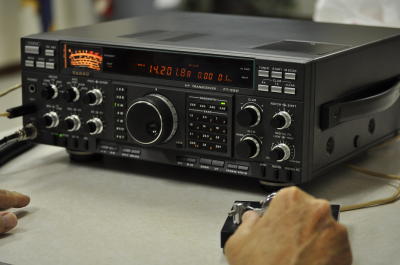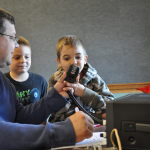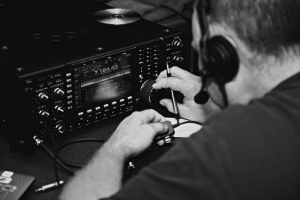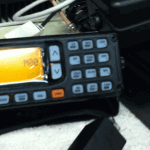What is Amateur Radio
A retired military officer in North Carolina makes friends over the radio with a ham in Lithuania. An Ohio teenager uses her computer to upload a chess move to an orbiting space satellite, where it’s retrieved by a fellow chess enthusiast in Japan. An aircraft engineer in Florida participating in a “DX contest” swaps call signs with hams in 100 countries in a weekend. In California, volunteers save lives as part of their involvement in an emergency communications net. At the scene of a traffic accident on a Chicago freeway, a ham calls for help by using a pocket-sized hand-held radio. A Georgia Tech student uses a car-mounted radio to alert the rest of Atlanta to an accident on I-75.
This unique mix of fun, public service and convenience is the distinguishing characteristic of the hobby called Amateur Radio. Although hams get involved in Amateur Radio for many reasons, they all have in common a basic knowledge of radio technology, regulations and operating principles, demonstrated by passing an examination for a license to operate on radio frequencies known as the “Amateur Bands.” These frequencies are reserved by the Federal Communications Commission for use by hams at intervals from just above the AM broadcast band all the way up into extremely high microwave frequencies.
But Isn’t That Like CB radio?
Amateur radio is different from CB radio. Amateur radio operators hold licenses from the FCC, and operate by clearly defined set of rules. We always give our callsigns when we transmit, so there is never any doubt as to who is speaking, and we refrain from using foul language on the air. In general, hams are polite and friendly, in sharp contrast to some of the activity on CB. And since amateur radio operators must pass exams on radio theory, interference avoidance, and RF safety, we are allowed to use much more transmitter power than CBers, build and modify our own equipment without consulting the FCC, and transmit on a huge range of frequencies.
Who’s The Typical Ham radio operator?
Amateur radio operators come from all walks of life—movie stars, missionaries, doctors, students, politicians, truck drivers and just plain folks. They are all ages, sexes, income levels and nationalities. But whether they prefer Morse Code on an old brass telegraph key through a low power transmitter, voice communication on a hand-held radio or computer messages transmitted through satellites, they all have an interest in what’s happening in the world, and they use radio to reach out.
What’s The Appeal Of Ham Radio?
Some hams are attracted by the ability to communicate across the country, around the globe, even with astronauts on space missions. Others build and experiment with electronics. Computer hobbyists find packet radio to be a low-cost way to expand their ability to communicate. Those with a competitive streak enjoy DX contests, where the object is to see how many distant locations they can contact. Some like the convenience of a technology that gives them portable communication. Others use it to open the door to new friendships over the air or through participation in one of more than 2000 Amateur Radio clubs throughout the country.
A Noble History
Nobody knows when Amateur Radio operators were first called “hams,” but we do know that Amateur Radio is as old as the history of radio itself. Not long after Guglielmo Marconi, an Italian experimenter, transmitted the Morse Code letter “s” from Newfoundland to England in 1901, amateur experimenters throughout the world were trying out the capabilities of the first “spark gap” transmitters. In 1912 Congress passed the first laws regulating radio transmissions in the U.S. By 1914, Amateur experimenters were communicating nation-wide, and setting up a system to relay messages from coast to coast (whence the name “American Radio Relay League”!). In 1927, the FCC was created by Congress and specific frequencies were assigned for various uses, including ham bands.
Why A License
Although the main purpose of Amateur Radio is fun, it is called the “Amateur Radio Service” because it also has a serious face. The FCC created this “Service” to fill the need for a pool of experts who could provide backup emergency communications. In addition, the FCC acknowledged the ability of the hobby to advance the communication and technical skills of radio, and to enhance international goodwill. This philosophy has paid off. Countless lives have been saved where skilled hobbyists act as emergency communicators to render aid, whether it’s an earthquake in Italy, a flood in India or a hurricane in the U.S.
What’s The Right License For Me?
Over the years, three basic license classes have evolved. The higher the class license you have, the more privileges you get. But each higher class license requires progressively more knowledge of technology, rules and regulations. So, you can learn the basics or you can become an expert and still enjoy the hobby.
Today, the “entry level” license for Radio Amateurs is the easy-to-earn “code free” or Technician Class license, which requires a short 35-question quiz on radio theory, regulations and operations. The Technician class license gives access to frequencies in the VHF and UHF bands (as well as a few HF bands), all modes of operation, and access to Amateur Radio Orbiting Satellites (OSCARS). See our homepagefor upcoming license exam dates.
The General class license grants access to most HF frequency ranges, which allow direct communication with the other side of the world. HF communication is a challenge to master, but it’s also a lot of fun. The General license requires a fairly straightforward multiple choice exam. Morse code is no longer a requirement for any amateur radio license.
Finally, the Amateur Extra license allows full access to all amateur radio frequencies. If you already have a General class license, Extra requires just one more written exam. The Extra-only frequency ranges are less congested than the others, and are a great place to experiment with low power communication without getting drowned out by high power stations.
Many amateur radio operators go all the way to the Extra class license eventually, but Technician is a great place to start, and allows you to get a feel for amateur radio without too much of a time investment. You can take license exams whenever you feel you are ready for the next level. Our club holds official FCC exam sessions on campus once a month.
Why Do They Call Themselves “Hams”?
Although the origin of the word “ham” is obscure, every ham has his or her own pet theory. One holds that early Amateurs were called hams because they liked to “perform” on the air, as in “hamming it up.” Another proposes that the name came from the “ham-fisted” way some early Amateurs handled their code keys. The easiest to accept is that “ham” is a contraction of “Am,” as in Amateur. One of the most exotic holds that “ham” is an acronym from the initials of three college students who were among the first Radio Amateurs.
What Are the Amateur Radio Bands?
Look at the dial on a old AM radio and you’ll see frequencies marked from 535 to 1605 kilohertz. Imagine that band extended out many thousands of kilohertz, and you’ll have some idea of how much additional radio spectrum is available for amateur, government and commercial radio bands. It is here you’ll find aircraft, ship, fire and police communication, as well as the so-called “shortwave” stations, which are worldwide commercial and government broadcast stations from the U.S. and overseas. Amateurs are allocated nine basic “bands” (i.e. groups of frequencies) in the high frequency range between 1800 and 29,700 kilohertz, and another seven bands in the Very High Frequency (VHF) and Ultra High Frequency (UHF) ranges. Even though many Amateur Radio conversations may be heard around the world, given the right frequency and propagation conditions, Amateur Radio is basically two-way communication.
Where Do I Get More Information?
The three best ways to learn about Amateur Radio are to listen to hams on the Amateur bands, read about Amateur Radio in the numerous books and magazines devoted to the subject and, best of all, talk to hams face-to- face. Hams take pride in their ability to “Elmer” (teach) newcomers the ropes to get them started in the hobby. Most will welcome your interest. To find out more and get started with amateur radio please contact us.



